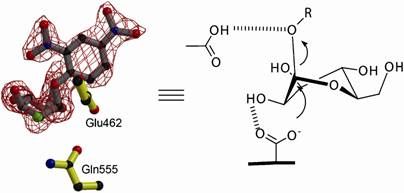Secrets of a chiral gold nanocluster unveiled
Researchers at the Department of chemistry and Nanoscience Center (NSC) of the University of Jyväskylä (Dr Olga Lopez-Acevedo and Professor Hannu Häkkinen) have resolved the structural, electronic and optical properties of a chiral gold nanocluster that remained a mystery for ten years. The theoretical structure was confirmed via comparison to experimental results obtained by x-ray diffraction from powder samples of the pure cluster material. The theoretical work was done in collaboration with researchers at Kansas State University and the experimental part at Hokkaido University. The team is supported by the Academy of Finland and the CSC – the IT Center for Science.
The synthesis of organothiolate-protected gold clusters of 1 to 3 nm in size has been well known since the mid-1990s, but the detailed atomic structure of the most stable clusters remained a mystery until very recently. In 2007, the structure of the first cluster that contained 102 gold atoms was resolved at Stanford University using single-crystal X-ray crystallography. The cluster now resolved has exactly 38 gold atoms and 24 organothiolate molecules covering its surface and it is just about one nanometer (nanometer = one millionth of a millimeter) in size. The shape of the particle is prolate (cigar-like), and 15 out if its 38 gold atoms reside on the protective surface layer chemically bound with the thiolate molecules. The gold-thiolate layer has a chiral structure, which is responsible for the observed chiral properties. The chiral structure has two structural forms (enantiomers), the so-called right-handed and left-handed forms, in a way comparable to a twist in a DNA molecule or to a twist in the staircase structure of a block of flats.
Chirality is a very common structural property of molecules in nature. The chiral nature of gold clusters influences the way they respond to circularly polarised light. This effect was first reported in experiments by Professor Robert L. Whetten's team at Georgia Institute of Technology (Atlanta, USA) exactly ten years ago. "We observed that particularly the 38-atom cluster (for which no structural information was available) is very sensitive for the polarisation of light, and the now-resolved structure finally explains our observations," comments Professor Whetten. In the future, chiral gold nanoclusters could be used as bio-compatible, enantioselective sensors, drug carriers or catalysts.
Most read news
Other news from the department science

Get the analytics and lab tech industry in your inbox
By submitting this form you agree that LUMITOS AG will send you the newsletter(s) selected above by email. Your data will not be passed on to third parties. Your data will be stored and processed in accordance with our data protection regulations. LUMITOS may contact you by email for the purpose of advertising or market and opinion surveys. You can revoke your consent at any time without giving reasons to LUMITOS AG, Ernst-Augustin-Str. 2, 12489 Berlin, Germany or by e-mail at revoke@lumitos.com with effect for the future. In addition, each email contains a link to unsubscribe from the corresponding newsletter.




















































